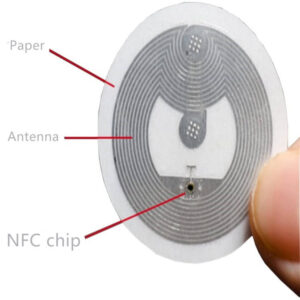Table of Contents
ToggleIntroduction
In our rapidly evolving world, technology continually progresses to enhance convenience, efficiency, and security in our daily lives. One such innovative technology that has gained considerable traction over the past few years is Near Field Communication (NFC) inlays. NFC inlays are small, embedded chips that enable a wide range of applications, with contactless payment being a prominent one. This comprehensive article explores the numerous benefits of using NFC inlays for contactless payment systems, detailing their mechanism, convenience, speed, security, compatibility, and future prospects.

Understanding NFC Inlays and Their Functionality
NFC inlays are compact chips integrated with a small antenna that allows them to communicate with NFC-enabled devices, such as smartphones, tablets, wearables, and contactless payment terminals. These chips contain critical information that can be transmitted wirelessly when an NFC-enabled device is brought into proximity with the inlay.
The interaction between an NFC inlay and an NFC-enabled device is quick and efficient. The inlay transmits its stored data via radio waves within a short range, typically a few centimeters. The receiving device processes this data to complete various functions, including transactions, identity verification, and data exchange. This short-range communication ensures that transactions are intentional, reducing the risk of accidental or unauthorized exchanges.
Convenience and Speed
One of the most significant advantages of using NFC inlays for contactless payment is the incredible convenience and speed they provide. With just a simple tap or wave of an NFC-enabled device on an NFC inlay, the payment process is initiated and completed within seconds. This quick and easy operation enhances the customer experience, particularly in fast-paced environments like retail stores, cafes, public transportation, and entertainment venues.
The ability to make rapid transactions is particularly valuable in reducing queue times, which can be a major deterrent for customers in busy settings. NFC inlays enable a seamless flow of customers through checkouts, thereby improving overall service efficiency and customer satisfaction. Retailers also benefit from faster transaction times as they can handle more customers in a shorter period, potentially increasing sales and boosting profitability.
Enhanced Security and Privacy
Security and privacy are paramount concerns for any payment system, and NFC inlays excel in these areas. NFC technology uses sophisticated encryption methods to protect the data transmitted between the inlay and the NFC-enabled device. This encryption ensures that sensitive information, such as transaction details and financial data, remains secure from potential eavesdroppers or cyber-attacks.
One of the key security features of NFC inlays is that they do not store sensitive information, such as credit card numbers, directly on the chip. Instead, they use tokens or unique transaction identifiers, which are only valid for one-time use. Even if an NFC inlay is intercepted, the data it contains is essentially useless to hackers. This tokenization process minimizes the risk of data breaches and provides consumers with greater peace of mind when making contactless payments.
Moreover, the close-range nature of NFC communication (usually within a few centimeters) adds an additional layer of security. It reduces the likelihood of unauthorized access or accidental transactions. Users can be confident that their payments are intentional and controlled, safeguarding their financial information.
Compatibility and Versatility
NFC inlays are remarkably versatile and compatible with a vast array of devices and payment systems. They work seamlessly with numerous NFC-enabled gadgets, including smartphones, tablets, smartwatches, and contactless payment terminals. The widespread adoption of NFC technology by major payment networks and service providers has enhanced its compatibility, making NFC inlays a practical option for a variety of applications.
Consumers can use NFC inlays for contactless payments virtually anywhere—from grocery stores and restaurants to public transportation systems and vending machines. This broad compatibility ensures a seamless and consistent payment experience across different contexts. It simplifies the payment process for consumers, allowing them to use a single method for multiple scenarios, thereby reducing the need for carrying multiple payment cards or cash.
The versatility of NFC inlays extends beyond payments. They can be integrated into loyalty programs, access control systems, and even for identity verification purposes. For example, some public transportation systems use NFC inlays for fare collection, allowing commuters to tap their smartphones or NFC-enabled cards to pay for their rides. This multifaceted utility makes NFC inlays a compelling choice for businesses and consumers alike, offering a unified solution for various needs.
Future Prospects and Technological Advancements
As technology continues to advance, the potential applications and benefits of NFC inlays are expected to expand further. Innovations in NFC technology are driving enhancements in data transfer speeds, security protocols, and integration capabilities. These advancements are likely to make NFC inlays even more efficient, secure, and versatile in the future.
Integration with emerging technologies such as blockchain and artificial intelligence (AI) could further bolster the security and functionality of NFC-based systems. For instance, blockchain technology can enhance the integrity and traceability of transactions, while AI can provide predictive analytics and personalized user experiences based on NFC transaction data.
Furthermore, the proliferation of the Internet of Things (IoT) presents new opportunities for NFC inlays. They can play a crucial role in facilitating secure and efficient communication between interconnected devices, creating a more cohesive and intelligent ecosystem. Whether it’s for smart homes, healthcare applications, or industrial automation, NFC inlays are poised to become an integral component of the IoT landscape.
Conclusion
In summary, NFC inlays offer a myriad of benefits for contactless payment systems, including unmatched convenience, speed, enhanced security, extensive compatibility, and versatile applications. As technology continues to evolve, NFC inlays are set to become even more integral to our daily lives, providing consumers and businesses with a secure and streamlined method for conducting transactions and beyond. Whether you are a retailer aiming to improve the customer experience or a consumer seeking a more efficient payment process, NFC inlays represent a valuable and forward-thinking solution that can cater to a wide range of needs.
